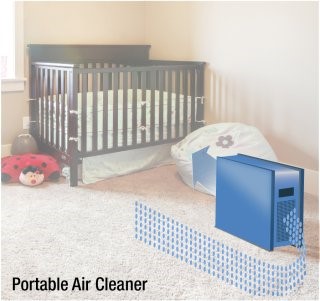Indoor air contains pollutants which affect human health. Some of these pollutants come from outdoors, and others come from indoor sources and activities, such as cooking, cleaning, secondhand smoke, building materials, consumer products, and home furnishings. These indoor air pollutants are particles or gases, including volatile organic compounds (VOCs). Common contaminants found indoors include particulate matter (including PM2.5 [fine] and PM10 [coarse]), formaldehyde, mold, and pollen. Indoor air quality will vary from home to home and over the course of a day within a home. Since most people spend about 90% of their time indoors, mostly in their homes, much of their exposures to airborne pollutants will happen in the home. Click here for a guide to indoor air cleaners in the home.

The most effective way to improve your indoor air is to reduce or remove the sources of pollutants and to ventilate with clean outdoor air. Research consistently shows that air filtration is an effective supplement to reduce pollutants. Using a portable air cleaner helps to improve indoor air quality. Portable air cleaners, also known as air purifiers or air sanitizers, are designed to filter the air in a single room or area.
Tips For Selecting a Portable Air Filter
When selecting a portable air cleaner, keep in mind:
- Make sure your air filter will eliminate all of the types of air pollutants in your home. Note that most filters are designed to filter either particles or gases. Make sure your filter is effective against both particles and gases.
- Make sure your air filter removes VOCs. The best air filters also target specific types of gases or VOCs. Make sure the one you pick does too. Consult the specific product packaging or labeling for more information.
- All air filters need regular cartridge replacement. If an air filter is dirty and overloaded, it won’t work well.
PORTABLE AIR CLEANERS

To filter particles, choose a portable air cleaner that has a clean air delivery rate (CADR) that is large enough for the size of the room or area in which you will use it. The higher the CADR, the more particles the air cleaner can filter and the larger the area it can serve. Most air cleaner packaging will tell you the largest size area or room it should be used in. Portable air cleaners often achieve a high CADR by using a high-efficiency particulate air (HEPA) filter. Click here to learn how to pick a portable air filter.
To filter gases, choose a portable air cleaner with an activated carbon filter or other filter designed to remove gases. Note that there are no widely used performance rating systems for portable air cleaners or filters designed to remove gases. The CADR rating system is for particles only. Activated carbon filters can be effective, provided that there is a large amount of material used in the filter.
A portable air cleaner with a high CADR and an activated carbon filter can filter both particles and gases.
Generally speaking, higher fan speeds and longer run times will increase the amount of air filtered. An air cleaner will filter less air if it is set at a lower speed. More air will pass through the filter at higher fan speeds, so typically filtration will be greater at higher fan speeds. Increasing the amount of time an air cleaner runs will also increase air filtration.
Portable Air Cleaner Sizing for Particle Removal | ||||||
Room area (square feet) | 100 | 200 | 300 | 400 | 500 | 600 |
Minimum CADR (cfm) | 65 | 130 | 195 | 260 | 325 | 390 |
Note this chart is for estimation purposes. The CADRs are calculated based on an 8-foot ceiling. If you have higher ceilings, you may want to select a portable air cleaner with a higher CADR. | ||||||
Here is the EPAs question and answer on portable air filters:
Common Questions on Air Cleaning and Filtration
Do portable air cleaners used in homes have the potential to improve my indoor air quality?
Yes. Most portable air cleaners and furnace/HVAC filters can filter particles from the air. Some can filter the small particles of greatest health concern (PM2.5). There are also air cleaners and filters that can filter both particles and gases. The longer the air cleaner runs, the more air it filters. Note that it is always important to reduce or remove the sources of indoor air pollutants and to ventilate with clean outdoor air. Filtration does not replace the need to control pollutants and ventilate.
Can portable air cleaners reduce allergy or asthma symptoms? Multiple studies with portable HEPA air cleaners have found improvements in one or more allergy and/or asthma symptom(s).
Can portable air cleaners solve mold problems?
No. Portable air cleaners do not address the cause of mold and musty odors. Mold is caused by a water or moisture problem in the building that allows the mold to grow. To solve a mold problem, get rid of the source of the moisture and clean up the mold. Portable air cleaners and may remove some of the particles generated by mold. In some cases, they may also help reduce odors, but they will not resolve a mold and moisture problem.
Q&A: Portable Air Cleaners
What is a CADR rating?
Most portable air cleaners are rated according to their clean air delivery rate (CADR). This number is intended to help consumers select an air cleaner based on the size of the area it will be placed in. The higher the CADR, the more particles the air cleaner will remove and the larger the area it can serve. The rating is typically measured at the air cleaner’s highest speed.
How do I choose a portable air cleaner that will remove the small particles of greatest health concern (PM2.5) effectively?
Some air cleaner packaging will indicate CADRs for removing three specific types of pollutants: tobacco smoke, dust, and pollen. These pollutants are used as examples to represent small-, medium-, and large-sized particles, respectively. To remove small particles, choose a portable air cleaner that has a high CADR for tobacco smoke, which represents the smallest particles. The CADR should be large enough for the size of the room or area you will use it in.
How do I calculate the size of the room or area in order to pick the right air cleaner?
Multiply the length and width of the area in which you intend to operate the air cleaner. The result will provide you with the size of the room or area in square feet. Compare this to the maximum recommended room size on the product packaging. If you have an open floor plan, you should consider the entire space that the air cleaner would serve. If you have high ceilings (above 8 feet), you should consider using an air cleaner that is sized for a larger area. If you have an area that is larger than any available product will serve, you could consider using multiple air cleaners.
How do I choose a portable air cleaner that can remove volatile organic compounds (VOCs)?
Choose a portable air cleaner with an activated carbon filter or other absorbent filter designed to remove gases. They can be effective when there is a large amount of material used in the filter (the thicker the better). Research has not yet shown that other technologies such as plasma, photocatalytic oxidation, or ultraviolet (UV) light can remove gases effectively in portable residential air cleaners.
Do portable air cleaners have noise ratings?
Noise ratings are reported for some portable air cleaners. The rating may be shown on the product packaging. Noise levels depend in part on the fan speed setting. If noise might prevent you from running the unit, you might consider an air cleaner that has a low published noise rating. For reference, a noise rating around 50 decibels (dB) is roughly the operating noise of a modern refrigerator.
Where should I put a portable air cleaner?
Consider placing the unit in the room(s) you spend the most time in. Many units are designed to be placed on the floor, although some are designed for tabletops. Either way, make sure the airflow is not obstructed. Keep air cleaners away from curtains and anything that might block airflow. If the air cleaner causes an uncomfortable draft, then redirect the airflow away from you.




